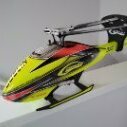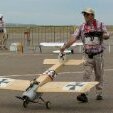Leaderboard
Popular Content
Showing content with the highest reputation on 08/05/24 in all areas
-
I have finally finished and test flown my 1970s Osprey 100in glider. I’ve had the wings built for 45 years and in the loft so finally decided to build the rest of it! I built a home made power pod so it can thermal from flat field or take the pod off and slope soar it,very relaxing in light winds!Only 2 channel,rudder and elevator. The only downside is I had a stroke last year which resulted in partial blindness so I can only fly when I have someone to spot for me and take over if I lose it!8 points
-
Another two for one project.My O/D OV10 Bronco 60in span that I designed for pss and electric that I’ve repaired after an oops!All the wiring is installed so all I have to do is spend half an hour inserting motors and props and then down to the field for a flight.All built up construction and plaster plug made,then sent away for vac forming.Controls are ailerons,flaps,rudders,elevator and throttles when needed.Does anyone else use an airframe for power and slope so they can get more bang for their bucks? I always try to design my scale airframes to do this,saves building two aircraft!Even build two wings for twins or multi engine and one fuz.5 points
-
I suffered a battery strap failure when a pack overheated and melted one of the two straps holding it in place. In the process of finding a strap of the right length, I came across this on Amazon with which you can make 30 battery straps for £7.99 delivered and, assuming a length of 50 cm for each strap, still have 4.5 m of velcro remaining! That's 26 p per battery strap. You can get 10 x 20 mm buckles here for £2.99 and make full use of that 4.5 m remaining velcro strip. The Velcro seems to have hook and loop embedded in it so it sticks to itself. I shall be using this for all my future battery strap needs, large and small!4 points
-
Its arrived. Postie just been with big box. Luckily Mrs. TR7V8 is at work so can be secreted to the garage quickly! Away for the weekend so further investigation will have to wait. Thanks Richard!4 points
-
OK, take 2! As already pointed out, the results were revised following Sainz's 5-second penalty. So here are our updated scores for the day; Pos League Rank Team Manager Pts 1 10 4 Pitts Specials john stones 252 2 5 2 Team Charles Picd Charles Pic 243 3 4 1 Revers Racing Pete B 238 4 2 0 Mannschaft Carl Brotherton 233 5 12 0 Torque of the devil Stu 218 6 1 0 Essex Racing Tony Clark 215 7 7 3 LetsGoTotoLetsGo GrumpyGnome 212 8 14 1 GASTON Formula Chris McG 204 = 8 1 Iqonic racing iqon 204 10 3 0 DMFC Racing Team Simon Webb 203 11 15 1 Norfolk Flyers Kevin Fairgrieve 186 = 11 3 teewrex John Tee 186 13 6 2 PSS Power Flyer 182 14 9 3 Hidden Cucumber fat brownie 179 15 13 2 The JP Specials johnpflyrc 173 16 16 1 Hans Brake Zoonie 134 Same top 3, though not quite so close on points as previously! Clearly something else was "missing" from the scores I posted on Sunday night, as we've all scored somewhat higher in the revised results... The overall table now looks like this; Pos League Rank Team Manager Pts 1 1 0 Essex Racing Tony Clark 1056 = 2 0 Mannschaft Carl Brotherton 1056 3 3 0 DMFC Racing Team Simon Webb 1022 4 4 1 Revers Racing Pete B 999 5 5 2 Team Charles Picd Charles Pic 967 6 6 2 PSS Power Flyer 946 7 7 3 LetsGoTotoLetsGo GrumpyGnome 917 8 8 1 Iqonic racing iqon 911 9 9 3 Hidden Cucumber fat brownie 907 10 10 4 Pitts Specials john stones 896 11 11 3 teewrex John Tee 895 12 12 0 Torque of the devil Stu 883 13 13 2 The JP Specials johnpflyrc 861 14 14 1 GASTON Formula Chris McG 856 15 15 1 Norfolk Flyers Kevin Fairgrieve 768 16 16 1 Hans Brake Zoonie 739 And now we do have a change at the top! Tony and Carl are now in joint top place. Simon remains in third place.3 points
-
As Paul says - paper gaskets are easy. Use a scalpel blade in a compass to cut out the centre circle. Put engine back together, trim the excess off. Quicker to do, than to find and order a fancy one. Exhaust gaskets, I don't bother. For two strokes, clean up as best you can then use a smear of slow epoxy when you assemble the thing, it will work far better and makes a perfect seal. Gaskets tend to allow the exhaust to loosen off.3 points
-
The tracking can be fickle , but keep in mind that Phill the kit cutter is doing ten or so at a time with careful consideration to the requirements of each order . Booking them all on line and labelling is also a time consuming job . More going out today , and tomorrow . I will put tracking details up as I get them .3 points
-
Bit of an update! only 3 years later!!! Maidened my glow Mini Jazz at the weekend. Has a new OS15 which is still bedding in. Flew lovely. Need to fit an engine cowl and finish building my electric one.3 points
-
Mega sale of Futaba transmitters, receivers etc. typical R2008SB s-fhss HV receiver £24.99 each instead of £54.99 All Products - Slough Radio Control Models (sloughrc.com)2 points
-
In addition to 2 fire extinguisher(foam - CO2) I have recently bought a fire blanket to contain any fire should the unfortunate happen. At least long enough for you to get out if it went up inside and prevent anything above/around catching fire accelerating the spread.2 points
-
2 points
-
Time for a little history. In the dim and distant past before they invented colour, bean juice (castor oil) was used in engines as a lubricant. Up to 30% was not uncommon for model engines in those days and castor was a very popular choice. This popularity was for good reasons. It was inexpensive, easy to get hold of, and did a good job as a lubricant. It was also quite viscous which could be an advantage if the fits within the engine were a little suspect as it gummed up the gaps. Crucially, it was better than synthetic oils of the day. Just ask the Germans in WWI. However, castor also makes a dreadful mess and leaves carbon/varnish all over the innards of your engine. The goo on the outside can also gum up cooling fins as dirt and bumble bees get suck to it, exhausts get blocked, and its prone to setting solid leaving your engine totally locked up. It is also a natural product and so its performance will always vary. As a result, you need more of it to guarantee the required lubrication. Fast forward to today and we have synthetic oils which are assembled molecule by molecule using computer controlled voodoo. Engines are made from vastly superior materials and with much tighter tolerances. Since the 90's 15% synthetic oil has been all you need and frankly even this is excessive with 10% probably a more realistic figure today. It always causes a row as not everyone has moved with the times but castor is a dead lubricant now and best forgotten. As they used to tell you at school, quality over quantity. When i was working at laser i did experiments with oil content. This was an offshoot from petrol engine work i was also doing. The petrol engine was running at 40:1 (2.5% i think that is?) at the time, so i wondered if a glow engine would work on that. I mixed up methanol and oil at the same ratio and left it running at 75% throttle for an hour, when it finally ran out of fuel. I then flew some of my own engines on 5% oil for a few years, this was no bother, and then introduced the low oil fuel at 7% to give a big improvement over standard 15% oil fuel, and give room for improvement later. Some customers have run their OS engines on the low oil fuel and had no problems, but i havent tested that so its on you if you have a go and it fails. Frankly, i think OS's would be fine, but as i dont fancy getting yelled at when someone kills their prized motor its not a recommendation from me, but 15% is fine for everything. If you stick to 15% oil, which you might as well do unless you have a laser, you can clean up your exhaust residue significantly by tuning the engine for peak performance and nut having it chuff around half a turn rich of peak and with a slow run needle set so the engine is on the verge of hydraulic lock. Always tune for peak performance on both needles.2 points
-
1 point
-
1 point
-
So ..... bringing this back from the dead now that my FMS Beaver has been repaired and getting close to being back in the " live hanger " squad. This has been on the back burner for some time. Never been maidened or even close to it. I have had a bit bother with push rods etc and now its time to refresh my memory as to where I left off. a few things as far as setting up the Beaver for another test run over the next couple of weeks but the Tiger 60 will have the cob webs blown orf and revived towards it initiation. I think my mate Aidan will enjoy this one as well as he has a vested interest in this. stay tuned for further activity coming soon. toto1 point
-
Mine arrived today. Thank you Richard.1 point
-
Thanks for the replies - as always this forum has people with knowledge on many things as well as RC models. Very helpful. It seems that PDB hit the nail on the head - my computer lacks TPM -Trusted Platform Module - That link to Microsoft showed how to check and well it isnt there. In a way i am happy to use old technology that still works, however the worry is that if any bank or credit card problem arises then the bank might not refund me and say it's my fault because i use software that is not updated! It's the old ' Nobody Ever Got Fired for Buying IBM ' thing - one tends to play safe and the computer companies rely on this to make sales. ( youngsters ask your grandad what IBM was if you don't know!) I might decide to switch to Linux in due course or I might buy another refurbished Windows 11 desktop from Stone Refurb. This current one came from Stone and was very cheap quite a few years ago and I recommend them to others. Look for Seniors or Student discounts and check the upgrades to large disc or SSD, DVD writer or whatever you need. Stock and prices seem to vary from day to day and a phone call to agree what items i needed adding had the package arrive next day. Easy!1 point
-
This is just rubbish. In the old days synthetic oils did not have the thermal tolerance of castor. Now, they exceed it. The idea that synthetic oil 'burns off' is probably 40 years out of date at this point and like castor oil itself, it needs to go away. As for the rest, adding a few % castor to a synthetic oil fuel will not produce the same carbon as a pure castor fuel, but the castor is inferior to the synthetic so you just made your fuel worse for no reason at all. And although the carbon build up will be slower, it will still happen especially in a 4 stroke. Ask my Enya 120 how i know this for sure... If you are 2nd hand shopping do not buy a Laser 45, 50, 61, 62, 75, or 90. They were discontinued in 1992 and there are no spares at all. A modern 70 will have spares when my former employer does the run and sends them to Model shop leeds. If you do look at a 2nd hand laser, post a thread here with a photo so its identity can be confirmed before you dish out the cash. Beyond that, if you can find an OS 70 surpass they are good engines. No spares for them either these days but generally they dont need them unless you lawn dart the model so...dont do that. Saito i think did a 65 and 72, enya did an 80 but they are rare beasts indeed. i would be wary of a 2nd hand ASP or SC these days unless its cheap. with cheap in mind If you want something for tinkering check out the bargain bins at model shows. Many engines have ended up there and prices can be very low indeed. Low enough that you can afford to blow another £20 on some new bearings (they will need them), have a crack at changing them, and still not feel cheated if the engine runs like a dog for some other reason. if there are multiples of the same engine all damaged in different ways a bitsa engine is always a possibility. I suffer emotional damage and bouts of uncontrollable rage watching youtube 'experts' talk about engines. Having worked for 13 years building and designing model 4 strokes i just find the videos painful to watch. Most of them havent a clue and just spout the same old modelling folklore nonsense we have seen for decades. Most of it was wrong from day one, and the rest is wrong because its now out of date. Like castor oil for example. While i am sure their efforts are mostly well intentioned and they simply do not know their information is wrong, a few will always be resistant to change and will continue the old narrative almost out of spite. In any case, while i applaud your efforts to research and learn you do risk being mislead by clueless halfwits who look professional with their flashy video, but the actual content is lacking. I am not trying to dampen your efforts to learn, but to be honest the best thing to do is just crack on and fire one up. 4 strokes offer little in the way of mystery and their operation is functionally the same as a 2 stroke from a user experience point of view.1 point
-
They certainly do Paul and many thanks for your kind comments.1 point
-
Well that was an excellent flight, don't those Saito engine run sweetly.1 point
-
1 point
-
You might get lucky in the event of catching the lipo whilst it is venting and before ignition, to be able to kick it away or chuck it out. Once it's lit up though, there is no way on earth that you would be able to pick it up and lob it outside. The venting with flames is very violent, even with a small lipo and they look to be virtually impossible to extinguish, so just need to be left to burn themselves out. The fire extinguisher's role is to put out any secondary fires of combustible material in the vicinity - the fire blanket is a great idea, just like a big pukka Lipo Sack. I'll be adding one to my charging station. Many years ago, on the rare occasion that I actually charged a large NiMh pack indoors, I caught it venting electrolyte steam and was able to grab the pack with some long handled tongs and lob it out of the landing window. You would need to be very lucky to do that with a lipo in the seconds before it lit up.1 point
-
I am not an expert (on anything!) but If I may say so, Simon, 46A is a heck of a lot of Amps to be putting through a 28mm dia. motor irrespective of whether it is a stock motor on the Durafly ME163 or not. The 4Max motor Shaun linked too was a similar spec. to your Aerostar motor and the max continuous Amps is 28A continuous and 35A for 10s. I am not surprised your model was ‘a bit a missile’ 😁(with a 7x4 prop) or the ESC ‘shorted out’! 🔥 Hopefully on your 4s Me163 there is better motor ventilation than on my 3s version. It could be informative if someone could type the numbers into Motorcalc? Anyway, I will be interested to hear what George at 4Max has to say. I hope you get it sorted in any event Simon. 👍1 point
-
here are some surnames and Parcel Force tracking numbers Russell UX6205166 Knowles UX6205170 Barker UX6205197 Cullen UX6205183 Naylor UX6244638 Youatt UX6244615 Orrells UX 6244536 Kent UX6244540 Harries UX6244575 Clementosn UX6244598 Atkins UX6244567 Timmis UX 6244607 Bird UX62445841 point
-
Yeah, foamies have their pros and cons, but they as a means to an end they are pretty effective. Once you are familiar they can be pieced back together super quickly too - don't take this as a criticisim (t isn't meant as one), but I could literally have completed this repair with some cyano, carnbon and a razor saw in less time than it took to type my combined responses in this thread! Such is the repairability of foam...1 point
-
Based on those pics there a still room to insert 2 or 3 short sections of 2-4mm wide carbon strip across the cracks and secure with superglue. That would have taken only a few mins and been plenty strong enough without the balsa, but leaving the wood there now won’t do any harm now. Certainly no need for a replacement part.1 point
-
I didn't show you all the steps I have taken since the above, as they are fairly self explanatory. The metal skid along the bottom of the fuselage. I got a piece of 20mm wide 1mm thick aluminium off Ebay, cut it to length, drilled 6 holes where shown on the plan at the front and back, countersunk the holes, then marked the relative positions on the balsa keel, drilled progressively bigger holes up to 6mm for the wooden dowels which I glued into position with the 5 minute PVA adhesive. This is a better hole gap filling glue than the Titebond Aliphatic Resin I also use. I then drilled pilot holes in the dowels, bent the skid to follow the shape of the keel and screwed it into position with 4mm screws. Balancing weight - the C of G is 85mm from the leading edge of the wing according to the plan. It needed quite a few pieces of lead to bring it into position. I feared that I had inset too much lead behind the P38 filler nose, but not so. With Reginald in the cockpit there is little room for even the receiver, so I had shoe horn it into the instrument binacle of the canopy. I now understand why Chris made it detachable with screws - so that one can insert lead inside it, which I screwed into position from underneath. Finally here are some pictures of it assembled. It weighs in at 7.62lbs, which is not far off Chris's estimate of 8lbs. It is a handsome beast. I now await a suitable day to launch off the slope. I still have to tidy up the servo wires inside the cockpit, glue in some guide tubes for the aerial wires, make some pieces of 2mm carbon rod to secure the wing joining bands, and make a wire hook for retrieving lost wing bands. Oh and very large radiator insulation bags, and some more "Petrel" vinyl sticker for the ailerons, plus stick on my Operator ID somewhere. Still stuff to do.1 point
-
Well we are nearly done with the airbrushing methinks. I have given the fuselage about 6 coats of white primer before overlaying about 4 coats of Flame Red which is the closest to Solarfilm Red I could find which I am using for the fin, the tailplane, and wings in combination with some clear for the flying surfaces. The cockpit area is masked off because that has been painted in white. It needs another coat of red before overlaying clear gloss lacquer. Next was the canopy which I completely covered with Tamiya yellow masking tape before drawing on the frame lines from the plan - width 4mm. I used the two flexible rulers you can see, which work really well. I then used a brand new blade in the scalpel to make sure of clean lines. You have to press but not too hard to avoid going through the plastic canopy as well s the tape. The first coat is just plain white to give the inside of the canopy the correct colour and also to give the red the correct base. I changed the nozzle of the airbrush from the fan shape to the single hole to get a narrower coverage.1 point












.thumb.jpg.6e9ca6f431386c6c58ab30794f332751.jpg)